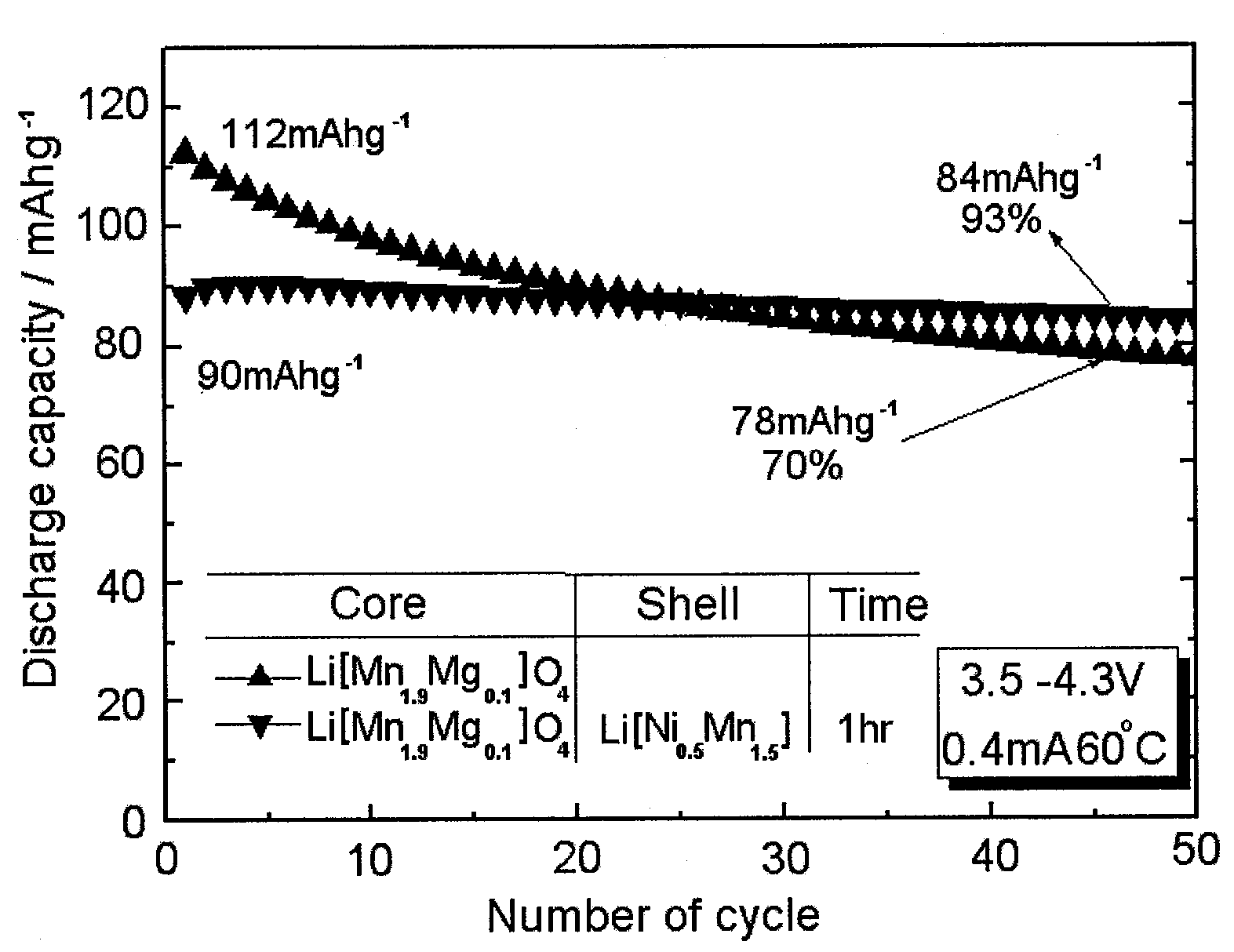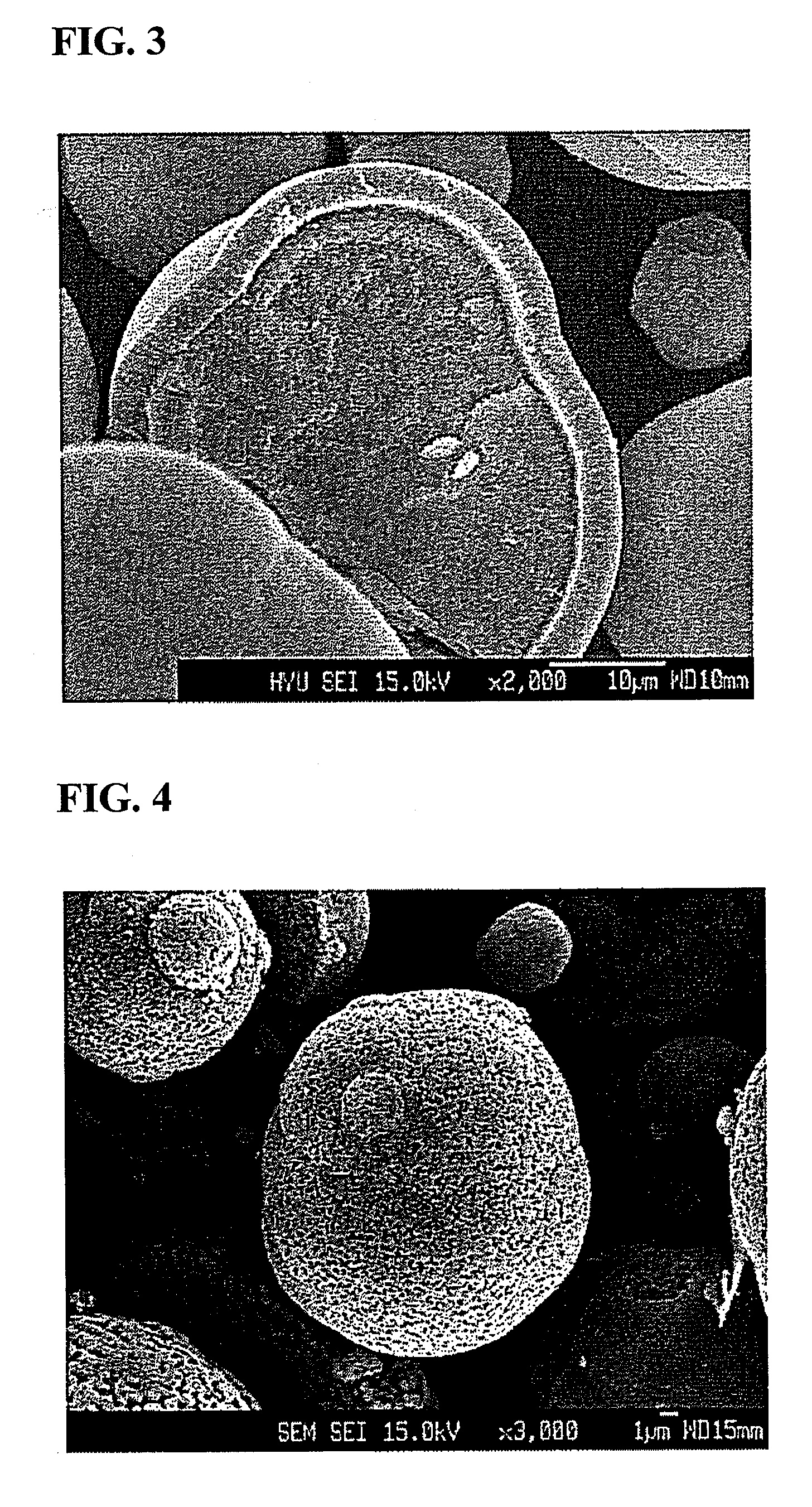Layered Core-Shell Cathode Active Materials For Lithium Secondary Batteries, Method For Preparing Thereof And Lithium Secondary Batteries Using The Same
a lithium secondary battery and active material technology, applied in the field of secondary lithium batteries, can solve the problems of high cost of cobalt components, inability to commercialize liniosub>2/sub>, and inability to meet the requirements of lithium secondary batteries, and achieve the effect of high capacity
- Summary
- Abstract
- Description
- Claims
- Application Information
AI Technical Summary
Benefits of technology
Problems solved by technology
Method used
Image
Examples
example 1
[0064]1) Preparation of Spheric Manganese Carbonate
[0065]Into a coprecipitation reactor (capacity 4L, equipped with an 80 W rotary motor) was poured 4 liters of distilled water, followed by the addition of 80 ml of a 0.32 M hydrazine (H2NNH2) solution to the distilled water. Nitrogen gas was supplied at a rate of 1 liter / min to generate bubbles within the reactor, so as to remove dissolved oxygen while the reaction was maintained at 50° C. and stirred at 1,000 rpm.
[0066]Both a 1 M metal salt solution, in which manganese sulfate was mixed with magnesium sulfate at a 0.95:0.05 molar ratio, and a 0.5M aqueous ammonia solution were fed at a rate of 0.3 L / hr into the reactor. 5 liters of a 2M ammonium hydrogen carbonate (NH4HCO3) and 100 ml of a 0.32M hydrazine solution were mixed so as to adjust the pH of the reaction to 7.
[0067]An impeller was set to have a speed of 1,000 rpm to allow the solution to stay in the reactor for 6 hours on average. After the reaction reached a steady state,...
experimental example 1
Assay for Cathode Active Material Characteristics
[0074]The cathode active materials obtained in Example 1 and Comparative Example 1 were photographed using SEM and XRD.
[0075](1) SEM
[0076]A SEM photograph of the bilayer spinel-type oxide particles obtained in Example 1 is shown in FIG. 4. As seen in this photograph, the particles were found to have a diameter of 30 μm or larger with a narrow particle size distribution, and to be spherical.
[0077]The bilayer core / shell structure of the particles is apparent from the cross section of the particle as shown in FIG. 3.
[0078](2) XRD
[0079]Using an X-ray diffractometer (Model Rint-2000, Rigaku, Japan), the particles were analyzed for X-ray diffraction patterns. XRD diffractograms of the precursor [(Ni0.5Mn1.5)x(Mn1.9Mg0.1)1−x]2O3 calcined at 500° C. and the cathode active material Li1+a[(Ni0.5Mn1.5)x(Mn1.9Mg0.1)1−x]2O4 sintered at 800° C. are given in FIGS. 5 and 6, respectively. No peaks responsible for impurities were found in the XRD diffr...
experimental example 2
Assay for Battery Characteristics
[0080]A battery employing the bilayer cathode active material prepared in Example 1 was evaluated for characteristics using an electrochemical analyzer (Model: Toscat 3000U, Toyo, Japan). In this regard, a charge and discharge experiment was carried out at 30° C. and 60° C. in a potential range from 3.5 to 4.3 V with a current density of 0.2 mA / cm2. A slurry was prepared by mixing the cathode active material powder prepared in Example 1, with the conducting material acetylene black and the binder polyvinylidene fluoride (PVdF) in a weight ratio of 80:10:10. The slurry was uniformly layered on an aluminum foil 20 μm thick, followed by drying at 120° C. in a vacuum. In a well-known process, the cathode thus obtained was separated from a lithium foil counter electrode by a porous polyethylene membrane separator (Celgard 2300, 25 μm thick, Celgard LLC), with a 1 M solution of LiPF6 in a mixture of 1:1 volume of ethylene carbonate and diethyl carbonate se...
PUM
 Login to View More
Login to View More Abstract
Description
Claims
Application Information
 Login to View More
Login to View More - R&D
- Intellectual Property
- Life Sciences
- Materials
- Tech Scout
- Unparalleled Data Quality
- Higher Quality Content
- 60% Fewer Hallucinations
Browse by: Latest US Patents, China's latest patents, Technical Efficacy Thesaurus, Application Domain, Technology Topic, Popular Technical Reports.
© 2025 PatSnap. All rights reserved.Legal|Privacy policy|Modern Slavery Act Transparency Statement|Sitemap|About US| Contact US: help@patsnap.com



